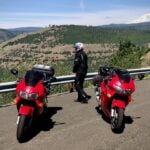A look back through the history of the world famous motorcycle race
With the 80th running of the acclaimed Daytona 200 this year, we thought a dive into the archives to view the long and storied history of this legendary motorcycle race was in order. From it’s actual origins in Savannah, Georgia in 1932, to the sands of Daytona Beach, ultimately riding the high banks of the Daytona International Speedway, the Daytona 200 has attracted many of the top motorcycle racers in the world to come make their mark on the “World Center of Speed”.
The maelstrom of early Daytona 200 racing
Interestingly, the Daytona 200 originated in Savannah, Georgia. The Southeastern Motorcycle Dealers Association organized a 200-mile dirt track race at the old Vanderbilt Cup course near the Georgia coastal town, and riders competed on Class C motorcycles of the type that were utilized by the AMA Grand National Championship at the time. After two years, the race outgrew the Vanderbilt site and was relocated to a course near Jacksonville, Florida for a year before returning to Savannah in 1936.
The sands of Daytona Beach had been used for land speed racing since 1902, but by 1935 most land speed runs were being held at Bonneville Salt Flats. A local Florida race promoter named Bill France Jr. arranged for the Savannah 200 to relocate to the then 3.2 mile Daytona Beach Road Course in 1937, got the sanctioning of the AMA, and the Daytona 200 was born. The very first race on the sand-road course was won by none other than Ed Kretz, on an Indian Sport Scout.
Ed Kretz, Daytona 200’s first winner
The races were suspended from 1942-46 due to World War II restrictions, but resumed in 1947. The next year, the course was moved further south towards Ponce Inlet, and expanded to 4.1 miles in length. Harleys, Indians and Brit brands (Norton, BSA, Triumph) dominated the podiums from the late 1940s-60s, with Harley-Davidson taking the most top trophies with 16 total wins since 1938. None of them would ever dominate the Daytona 200 again after 1969, with the sole exceptions being BSA in 1971 in the hands of Dick Mann, and Danny Eslick on a Triumph in 2014. (After this initial publishing, Brandon Paasch successfully defended his ’21 title, winning the 2022 race on a TOBC Racing Triumph Street Triple RS)
Harley-Davidson KRs getting sideways in the sand
As urban development began to encroach on the race locale, Bill French started looking for alternatives. He found a site near the Daytona airport and in 1957, construction began on a 2.5 mile paved, oval shaped course with high banks for higher speeds, known as the Daytona International Speedway. The new facilities opened in 1959, but it took two more years before French could convince the AMA to move the beach race to the Speedway. As soon as the move deal was inked, racers quickly adapted to the new, high-speed paved course, dumping their dirt track motorbikes for road racers of the type employed in Grand Prix racing.
At first, the 31 degree high banks weren’t used by the motorcycle races due to AMA concerns about rider safety, utilizing an infield course, but in 1964 riding the banks was approved, and the race took the daunting, dramatic shape it now runs. Many dirt/beach course traditionalists initially shunned the new track and format, but as French continued to heavily promote the whole event, even getting it billed as the centerpiece of the Daytona Bike Week, the Daytona 200 began to attract racers and fans from around the world, seeing record attendance across the 1970s.
The Daytona 200, 1960s. A starting grid, and Gary Nixon taking a win.
The 1970s also saw the rise of the Japanese brands dominating the grids and the podiums. In fact, Dick Mann won Honda’s first Daytona 200 in 1970. Yamaha would soon come to dominate the Speedway, first with Don Emde in 1972, then taking 13 consecutive wins through 1984. With the exception of Ducati in 2011 ridden by Jason DiSalvo, no Euro brand has won the trophy since the Japanese brands domination. Yamaha has led all of the manufacturers in total wins, followed by Harley-Davidson, with Honda, Kawasaki, and Suzuki all giving chase.
Don Emde ripping it astride his Yamaha TR3 on his way to the 1972 Daytona 200 win.
The race has attracted top riders here in America as well as famous riders from around the world. Everyone from Floyd and Don Emde, the first father/son duo to win the races, to Gary Nixon, Cal Rayborn, Dick Mann, Kenny Roberts, Freddie Spencer, Eddie Lawson, Wayne Rainey, Scott Russell (Daytona 200’s winningest racer with 5 trophies) and Nicky Hayden, among too many others to name, have come and won at Daytona. From abroad, Canadian Billy Matthews was the first non-American rider to win the Daytona 200, in 1941 and 1950 on the old beach course. Jarno Saarinen of Finland surprised the field by taking the checkered flag at the Speedway in 1973, followed by the legendary Giacomo Agostini in 1974. Canadian Miguel Duhamel and Aussie Mat Mladin have left their permanent marks on the Daytona 200, as have NZ’s Graeme Crosby and UK’s Chaz Davies. The Daytona has truly become an international motorcycle racing spectacle.
Eddie Lawson and Scott Russell battling for the 1993 Daytona 200 title. Lawson took the win. Photo by Henny Ray Abrams.
Last year’s race saw one of the most dramatic photo-finishes in recent 200 memory, with Brandon Paasch drafting Sean Dylan Kelly through the final laps of the race, only to slingshot around him for the win by a mere .03 second margin. Watching these racers take to the high banks on their motorcycles, wide open on the throttles, is a heart-pounding thrill to behold. So many racers say there’s really nothing in the world quite like it. The infield track is tight and curvy, but when they open it up along the outer track, the speeds they attain and remain at until the returning infield chicane is nothing short of epic. The track is so fast, and the banks can be so dangerous in the event of an off, that Superbikes no longer race on the course. The race became a Supersport one in 2005 due to the excessive tire wear and extreme speeds riders and bikes were achieving on-track.
Brandon Paasch’s photo finish over Sean Dylan Kelly in the 2021 Daytona 200. Photo by MotoAmerica/Brian J. Nelson.
For 2022, the MotoAmerica road racing series has taken over management of the Daytona 200, making some changes to be in compliance with FIM international rules, and introducing several other classes to the weekend of racing- The wildly popular “King of the Baggers” race, the rapidly growing Twins Cup, and the wild and crazy Roland Sands Design Super Hooligans class, all taking to the legendary track. As the history of the Daytona 200 continues to be written, the race is regaining its place as one of the premier motorcycle road races in the world. Last year, Northern Irish Superbike rider and Isle of Man multi-year winner Michael Dunlop came to compete in the Daytona 200, adding further legitimacy to the resurgence of the classic event.
May the Daytona 200 live on as one of motorcycling’s greatest races.
For more on the Daytona 200 and how to tune in, click here:
Check out last year’s fantastic finish, as captured by Motorsports on NBC-
































Not a mention of ASRA/CCS taking over the event from AMA and saving it to continue the tradition. Shame on the author for neglecting this fact.
Thank you for sharing this specific, but the point of the article was to give the overarching history of the grand event, not necessarily the minutiae of what entity managed the race from year to year.